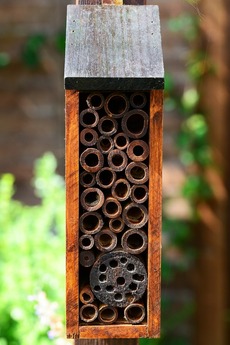Bee Hotels
Bee Hotels give wild bees and a number of other insects a place for resting, shelter and feeding. Even though solitary bees do not make honey, they are important pollinators and are much less likely to sting! Solitary bees will use the hotel as a breeding place and will lay their eggs inside the space provided. They build cells inside the spaces and add pollen and nectar which will later feed the larvae. Afterwards they seal the holes with leaves or mud.
Bee Hotels have become rather popular in the last year and there is an overwhelming choice of designs, materials and sizes. We gathered some easy instructions on how to build your own Bee Hotel and some important Do’s and Don’ts.
Bee Hotels give wild bees and a number of other insects a place for resting, shelter and feeding. Even though solitary bees do not make honey, they are important pollinators and are much less likely to sting! Solitary bees will use the hotel as a breeding place and will lay their eggs inside the space provided. They build cells inside the spaces and add pollen and nectar which will later feed the larvae. Afterwards they seal the holes with leaves or mud.
Bee Hotels have become rather popular in the last year and there is an overwhelming choice of designs, materials and sizes. We gathered some easy instructions on how to build your own Bee Hotel and some important Do’s and Don’ts.
|
How to build a Bee Hotel
|
|
Do
|
Don't
|
For more tips, and inspiration, check out this in-depth guide to bee hotels from Michigan State University.



